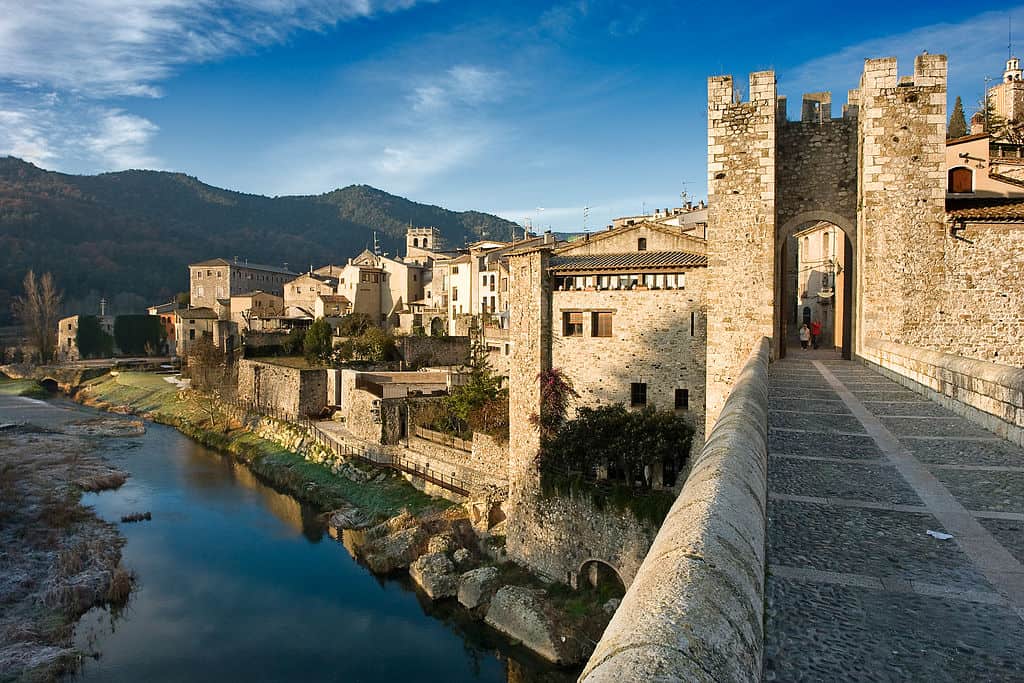The original name of Besalú was Bisuldunum and as the name indicates, it was a fortress between two rivers: the Fluviá to the south and the Capellades to the north.
Belonging to the region of La Garrotxa, in Catalonia, Besalú is a medieval town located at an altitude of 150 meters, currently famous for its medieval architecture.
The origin of the city was the castle of Besalú which is already documented in the tenth century, built on top of a hill where are the remains of the canonry of Santa María, in the High Middle Ages. The current layout of the town does not respond faithfully to its original state but it does make it possible to read the urbanization of the Middle Ages with the existence of important buildings: the bridge, the Jewish baths, the church of the monastery of San Pedro of Besalú and San Julián, old hospital of pilgrims, the Cornellá house, the church of San Vicente and the gothic room of the Palace of the Royal Curia.
Besalú shows an architectural and urban structure quite consistent with the medieval past. The monumental importance of Besalú is given fundamentally by its great value of set, by its unit, that determines it like one of the most important and singular samples of the medieval sets of Catalonia.
Miró I el Joven was the first independent count of Besalú. Besalú began to acquire importance as the capital of an independent county after the death of Wifredo el Velloso in the year 902, a condition that he lost when Bernat III, son-in-law of Ramón Berenguer III, died without issue; as a consequence, in 1111 the county of Besalú passed to the house of Barcelona.
In the nineteenth century, during the War of Independence, there was a battle with victory of Spanish troops under the command of Juan Clarós.
In 1966, it was declared a «National Historic-Artistic Ensemble» for its great architectural value. Currently, Besalú is developing an important social and tourist project, signaling the historic center to highlight the tourist attractions of the population and making excavations to investigate different archaeological finds.
Gastronomy in the La Garrotxa region
It is, therefore, an inland region that has elements of mountain cuisine such as mushrooms, snails, mountain herbs, the use of cereals and sausages. The following are the most outstanding elements of the gastronomy of this region:
Beans with pear sausage, a typical dish of Santa Pau.
Buckwheat porridge
Farro
«Stone Soup.»
Tortell tortilla or tortell d’Olot, a kind of aniseed bread
Sausages: The sausage and ham from Olot and Castellfollit are famous
Typical drinks
La Ratafia is a liqueur made with walnuts and brandy typical of the Catalan Pyrenees and especially La Garrotxa. The Ratafia Fair is held in Besalú at the Pont de la Puríssima in December.
Gastronomic fairs
The Garrotxa Gastronomic Show is held in November and December. In January, shortly after Sant Antoni, there is the Fira del Fesol or «Fesolada» in Santa Pau with a tasting of bean dishes. In February Olot celebrates the Fira de l’Embotit with a popular sausage. The Buckwheat Fair is held in the same village in November.
Iberinbound, iberinbound@iberinbound.com incoming travel agency in Girona, specialized in Group tours if they are Educational, Students, Leisure , ad-hoc groups, Shorex, MICE Bleisure. Relaxing on the beach is not everybody´s favourite holiday activity, as some rather prefer spending their time with traditional and folkloric festivals full of color and perfume.

